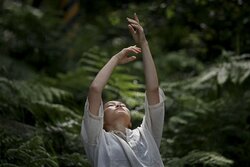-
Advertising in Taiwan
Video
Cultural differencies
This ad is funny because it reveals the culture differences between France and Taiwan. One in particular : the food.
In France, you will never find an advertisment for noodle soup. But in Taiwan the noodle soup is one of the most popular one, you can find it everywhere, in every convenient stores. They warmed you the soup and you eat it directly. Taiwanese even eat that as a snack!
At the begining it can appears strange because it's not in the french mentality to have a noodle soup everytime and several time during the day. But it's all about cultural differences and now that i'm close to the end of my semester i think one of the main difference of thoses two countries is the food. That's why i thought i was intersting to put an ad of the noodle soup.
Object of the advertisement
The object of the advertisment is the noodle soup and the target is all the Taiwanese in general.
The noodle soup by being one of the most popular courses in Taiwan concerned every Taiwanese because it's in their customs to eat that. It's like an ad about cheese in France.
In France
If this ad appears in France, French people will be confused. They will wonder why this ad and why noodles soup! The same if an ad about cheese appears in taiwan!
On top of that, it's funny because in this ad, the person who appears like an heroe is the Taiwanese man at the end with his bicycle who bring the noodle soup. Usually, In france the heroe who has the product is not a real character.
Exemple : Mr Propre or Pepito etc...
And this kind of ad ( with all the people gathering around the ladie to see what she needs ) is more for childrens in France.
But in taiwan you can find a lot of ad like that, a little bit over play. I think in France, ads are more realistic.
 votre commentaire
votre commentaire
-
Rice Production
Since I arrived in Taiwan, I did a lot of different visits to undersand better the taiwanese culture and learn about it as much as possible.
The Rice production was my favorite one, for one day we were following the farmers on the field to see their job but we also get to see the work in the factory.
That's why I want to share what i learn during this visit because rice production is really important in taiwanese culture as you can guess.
Introduction
Rice is a cereal grain and the seed of the rice plant. It's cultivated for more than 10000 years in China. It is the grain with the second- highest worlwide production.
Rice is now the most important source of storable food in the world. 687 million tonnes of rice were produced in 2009. They are many varieties of rice and culinary preferences, for exemple in the Far East, there is a preference forr softer and stickier varieties.
Rice has considerable cultural importance. It's often associated with prosperity and fertility. Therefore, there is the custom of throwing rice at weddings. In many cultures the word "rice" is the same as the word for meal. (Japan). And also, in China, people say " Have you eaten your rice today?" to say " how are you?"
Our visit of the rice production started with the field.
On the field
Normally rice is cultivated as a one year plant. The rice fields will be flooded in springtime and the young seedlings will be set in. Actually, the flooding is not necessary for the rice. Thought it needs a lot of water the reason is rather to need less weed and pest control during the growth season.
During the growth season the plants grow and farmers have to manage the water lever, the weed and pest control and take out unhealty rice plants.
The rice will be harvested in the fall season when the water content in the seed is less that 25%. After harvesting, there is treshing then the seeds need to dry. In traditional small farms the rice is usually dried in front of the house!
In the factory
I was really impressed when i saw the factory, all thoses huge machines just for rice!
First the Drying of the rice. Drying has to be done quickly and efficiently to prevent moulding. Mills range from simple hullers, with a through put of a couple of tonnes a day, that simply remove the outer husk, to enormous operations that can process 4,000 tonnes a day and produce polished rice.
After the seeds are dry enough they will be brought to the mill. Either the farmer sells the rice to the mill or the mill charges the farmer for the milling process.
 votre commentaire
votre commentaire
-
Music
In Taiwan, traditional music is usually played on solo instruments . Bamboo pipes and Qin are among the oldest known musical instruments from China. You can see them in a lot of differentes places in taiwan.
The traditional music is mainly played by orchestras, in some events, operas or theater. However, the popular music, often listened by young people experiencing a rise in popularity since the end of the 20th. And i can tell that in every club in taiwan you will only have commercial music, the same kind that in europe but sometimes some commercial music of taiwan.
Taiwanese people also really like K pop, korean pop music, with bands such as Girls Generation and with intruments such as electic guitar, bass, drums.
I also had the chance to attend a concert of electronique music, it was similar as what we can find in Europe.
Video of traditional taiwanese music
Theater/drama
Taiwanese peple often go to the theater to see different kinds of arts : Taiwan opera or puppet drama are the most known.
The Taiwanese Opera is famous in Asia. The story elements are traditionally based on folk tales of the Hokkien region, though in recent years stories are increasingly set in Taiwan locales. It's pretty much the same story all the time but adapted, with new characters etc.
The most popular kind of show, of performance in Taiwan is the Puppet drama. I saw once a Puppet drama in front of a temple. Some of them make them, some other play with them, and of course we can find some drama with those puppets. They are usually hiden under a larg costum and the puppeteer tells stories in adequacion to the chinese cultur.
Crafts
Taiwan is doted by a lot of crafts. You can find some everywhere either in marble or bamboo, lacquer, copper or rattan, furniture inlaid with mother of pearl, carpets and embroideries are the most prominent representatives of local handicrafts.
For shopping, the better it's to go in a Night Maket and you will find all kind of stores like flower stores, jade stores, electronic stores etc.
Another craft is Hello kitty, the famille little white cat, it's the figure in Japan and it's present everywhere in Taiwan ( maybe due to the period when taiwan was under Japanese rules). You can find it on clothes, glasses, bags...
Ancient craft tradition born in southern China, Taiwan's umbrella is a little umbrella local version. It's decorated with traditional painting and calligraphy.
Concerts
You can find a lot of concerts to attend in Taiwan but more in te capital (Taipei), not really in the city where i stayed (Taichung).
In taipei you can find all kinf of concerts, some rock music, classical music, electronic music ...
Since there is a lot of foreigners in Taipei, the programation of concerts adapt themselves to satisfied everyone.
Some famous band known in the whole word are giving representation in Taipei!
 votre commentaire
votre commentaire
-
Presentation
I arrived 3weeks ago and i was really impressed to see the difference between France or even Europe and Taiwan. I was really expecting to learn more about this country and of course about people way of life.
As a visitor in Taiwan, it was obvious that i had to respect their social customs and cultural differences. Some of them seem old but they are a part of their life and culture. Particulary, in visiting religious institutions.
Customs / Cultural habits
Removing shoes
The first thing i noticed when i arrived in Taiwan was the " romoving shoes". In practically every taiwanese home, as in Japan, guests are requested to remove their shoes even though the host sometimes insist that you don't have to ( but that is just courtesy).
I noticed that when I mooved into my appartment, i was wondering why the shoes were in front of each door in the building. I thought that it was weired to do that because someone can still the shoes, you will never see that in France and i will be scared to live my shoes outside my appartmement!! But my french way of thinking is obviously different that taiwanse!
Every host has slippers lying right at the door after removing their shoes. Taiwanese pride themselves in maintaining a clean floor at home!
Weddings
A few weeks after my arrival, i started to have a lot of different taiwanese friend. And one day, one of them invited me to a wedding. I didn't really know what to expect about it because it's such a different culture that i wasn't sure of anything. I asked her if i had to bring something special or even to dress in a special way..
Fortunately i asked her information, i didn't know that for Taiwanese weddings you have to present yourself with a red envelope. When you are invited to a wedding, you will be expected to bring money when attending the wedding. So, i had to place the money in a red enveloppe and the typical amount should be about NT600 to NT1000 in cash. This entitles you to a wonderful 10-course meal during the wedding party and you are not expected to bring other gifts.
Gift Giving
Taiwan is a great gift-giving society. When you visit someones house for dinner, it is customary to bring a gift. This may be some fruit, a box of chocolates, somes pastries, or a bottle of wine.
When you present a gift, tradition dictates that it be presented with two hands and received with two hands. The host will usually not open the present in your presence unless you request them to do so. When opening the gift in the host's prensence, it is important to open the package carefully to ovoid ripping and crumpling the paper. The wrapping paper should be folded up and put aside.
Bad Omens
One day, i was talcking to a taiwanese friend and in the discussion i pronounce the number "four" and she looked at me strangely. At
 the beginning i thought that it was because my accent was not that good so i repeated another time and she started laughting! I asked her why and she explained me that in chinese culture, the sound of "four" is similar to death and you try to never pronounce it.. I asked her more explications about it and I learned that for exemple hospitals never put patients on the fourth floor and some pople do not fell confortable about having an office on the 4th floor of a building.
the beginning i thought that it was because my accent was not that good so i repeated another time and she started laughting! I asked her why and she explained me that in chinese culture, the sound of "four" is similar to death and you try to never pronounce it.. I asked her more explications about it and I learned that for exemple hospitals never put patients on the fourth floor and some pople do not fell confortable about having an office on the 4th floor of a building. That's funny because after she told me that, i observed in a hostel where i stayed in Taipei that there were no 4th floor in the elevator, directly the 5th floor! I thought it was really funny and impressive how much there believe in bad omens.
But there is more! In Chinese, white is as well associated with death. In giving presents, i advise you to never use white wrapping paper or white envelopes ( like the French people always do!). Chinese are usually hesitant to open it because it indicates the writer is going to die soon.. ( Lucky i am to had heard about it before going to that wedding!!)
All that kind of topic disussion like death or talcking about accidents are generally forbidden in taiwanese culture.
Symboles of Taiwan
National flag
The "white sun in a blue sky" portion of the ROC's national flag was origanally designed by Lu Hao-tung, a martyr of the Chinese revolution.
The 12 points of the white sun in the emblem represent the Chinese conceptualization of a day's being divided into 12 two-hour periods, symbolizing unceasing progress. At one level, the three colors of blue, white and crimson stand for the Three Principles of the People : nationalism, democracy and social well-being.
At another level, the colors embody qualities that evoke other concepts enumerated in the Three Principles : The blue signifies brightness, purity and freedom, and thus a government that is of the people; the white, honesty, selflessness and equality, and thus a government that is by the people; and the crimson, sacrifice, bloodshed and brotherly love, thus a government that is for the people.
National flower
The plum blossom, was officially designated by the ROC Executive Yuan to be the national flower on July 21, 1964. The plum blossom, which produces shades of pink and white and gives off a delicate fragrance, has great symbolic value in Chinese culture because of its resilience during the harsh winter. The triple grouping of stamens ( one long and two short) represents Sun Yat sen's three Principles of the people, while the five petals symbolize the five branches of the ROC government.
National celebrations
New Year's Eve and Chinese New Year
Beginning in mid-December, families all around China start preparing Chinese New Year, creating an atmosphere of joy and renewal.
A time of gratitude and family togetherness, New Year's Eve is spent by bidding farewell to the old year and thanking one's ancestors and the gods for their blessing and protection. Children who have left their hometowns return on this day to share New Year's Eve dinner with their families, and for those unable to make the journey, a table setting is placed to symbolize their presence in spirit if not in body.

At the end of the dinner, the parents and older generation give New Year's money to the children, who have been waiting with growing anticipation for this moment to arrive. Finally, to watch the old year out and bring in the new year, families stay up.
With the arrival of New Year's day, life is renewed and the new year begins to unfold amidst to noise of firecackers.The Chinese begin the day by worshipping their ancestors, following which the streets become filled with poeple making New Yeear's visit to friends and relatives and with the lively display of dragon dancing, lion dancing... and other folk activities.

On the second day of the new year, married women return to their natal home to visit family; on the fourth day, the gods return to the world of the living; and on the fifth day, many new stores and old businesses open their doors for the first time due to the auspiciousness of the day !
Preserving and incorporating the values of these New Year traditions into modern day life is a goal Chinese people strive for...
Lantern festival
lantern festival, also known as Shang Yuan Festival, takes place on the fifteenth day of the first moon. Last in a series of springtime celebrations, this " second New Year" is widely celebrated by families all around Taiwan.
On the night of the festival, decorative lanterns depicting birds, beasts, historical figures, and any of number of different themes are carried by children or adorn temples. To highlight these glowing works of art, competitions are held. The Taipei Lantern Festival, held annually at Chiang Kai shek memorall Hall Plaza and the largest and most famous of these competitions, is attended every year by thousands of lantern-watchers. The lantern festival is further enriched by the customary lantern riddle parties that are held on this night.
Farmer's Day
Each year around the 15th of the first month on the Chinese calendar is the " Start of spring", marking the passing of winter and the arrival of spring.
This national event is to encourage farmers to finish preparations for spring plowing. the main activity is "whipping the spring Ox" , supervised by a lot of government officials to show the importance of agriculture.
The "spring Ox" is a colorful paper cow stuffed with "the five grains". While hitting the spring Cow, the following words are said " With the first hit comes timely and favorable weather; with the second comes fertile land and warm rains; with the third comes a peaceful start to a new year; with the fourth comes peace throught the four seasons; with the fifth comes a harvest of the five grains; and with the sixth comes springtime to the Six Unities or universe"
Ghost Festival
Just a the West has Halloween for ghosts, so also does Taiwan have a holdiay to fete the departed spirits of the underworld : Ghost festival, a popular occasion celebrated throughout China on the 15th day of the seventh lunar month.In Taiwan, Ghost festival is passed by slaughtering a pig and sheep, wich together with a prodigious table of wine and meat is offered to one's ancestors and ghost from the underworld.
The Chinese believe that the dead become ghosts roaming between Heaven and earth. Spirits without descendants to care for them are prayed to during ghost Festival so that they may also enjoy the warmth of life among the living.
Family habits in taiwan
Most Taiwanese live in urban areas, particulary modern apartments. They tend to wear western clothing, saving their traditional clothing for certain festivals.
Women enjoy a higher social status since industrialization along with more freedom. The underlying values that form the base of traditional values in Taiwan are proper relationships, practical wisdom, along with proper conduct.
The values come from Confucian ethics and since Confucianism was basically developed in rural areas, modern Taiwan is facing the challenge of adapting these values to modern time.
Some of the values have not lost any strengh such as keeping "face", faithfulness to parents and ancestors worship as well as having a strong work ethic.
Popular activities include traveling to other parts of the world, singing with family and friends, watching TV, and moutain climbing.
In the morning, the taiwanese like to get up early to practice exercices in parks or in front of their house.Young professionals like to frquent bars, restaurants and discos at night!
 votre commentaire
votre commentaire
-
Kenting
Two weeks ago, i was in Spring holidays, i had the opportunity to travel around Taiwan another time. First I went to Kenting, kenting is in the south of Taiwan, this place is really known for the beautiful beach that you can find over there and for Kenting national park. This national park is well known for its tropical climate and sunshine scenic mountain and beach. kenting was long been one of the most favorite resort places in Taiwan! For all thoses reasons i decided to go five days in this place !
I especially enjoyed the good wheter and the beach of course!
Taipei
After going to Kenting, i went to Taipei to visit and learn more about Taiwanese culture and it was amazing. I ate some of the most delicious food in the world, I met friendly people. I was fascinated by the old and new side by side, with the modern in one corner and the traditional at another.
Location
I was really well located because i stayed in a hotel in Zhongxiao East road, it's Taipei's main boulevard that connects the West with the East. It's Taipei's fashion street, full of high-class boutiques and shopping malls, pubs and clubs, fitness centers, spas ...
transportation
I really appreciated the transportation in Taipei, by using the Taipei MRT, it's really the best way to explore the city.The train is quick, extremely clean and not so crowded like in other big cities such as Seoul or Tokyo i guess... I bought an "Easy card", it's a smart card system, that enables you to pay for train or bus fares as well as for purchases in convenience stores.
Landmarcks
The first thing i did, when i arrived in Taipei was to visit Taipei101, one of the most incredible buildings the metropolis has to offer. The building ranked oficially as the world's tallest from 2004 until the opening of the Burj Khalifa in Dubai in 2010. Taipei 101 comprises 101 floors above ground and 5 flooes underground. The building was architecturally created as a symbol of the evoution of technology and Asian tradition. Despite the rapid construction of much taller structures in China and the Middle East, taipei 101 will always be worth to see because of the unique design that it's offer. i even had dinner in some restaurants on floors 86. It was a great experience.
I also went to the National Palace museum. It is the national museum of the Republic of China, and has a permanent collection of 693,507 pieces of ancient Chinese artifacts and atworks, making it one of the largest in the world.. The collection encompasses over 8000 years of Chinese history from the Neolithic age to the late Qing Dynasty. Most of the collection are high quality pieces collected by China's ancient emperors.
After all this great experciences, it was the end of the spring breaks.. Back to the reality so back to school!
 votre commentaire
votre commentaire Suivre le flux RSS des articles
Suivre le flux RSS des articles Suivre le flux RSS des commentaires
Suivre le flux RSS des commentaires






























